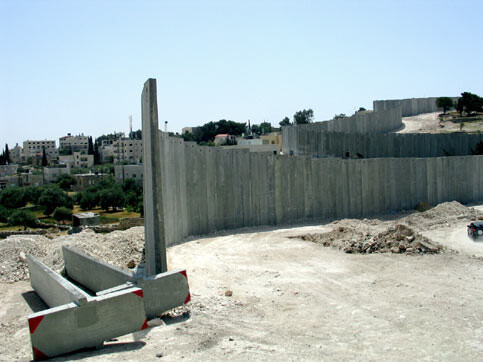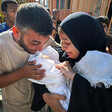The Electronic Intifada 15 December 2004

The wall at Abu Dis (Andrew Courtney)
The new documentary The Israeli Wall in Palestinian Land is a prime example of how low-cost digital technology has great potential for activists - with a small camcorder, and some decent video editing software, one can make a finished film that can be cheaply burned onto DVDs or put up on a website. Like cheap 35 mm, Polaroid, and disposable cameras democratized photography, video as a medium is now highly accessible. But whether one makes the most out of the medium is another matter.
The film features seven interviews with English-speaking Palestinians of various walks of life in locations such as the Deheisheh refugee camp near Bethlehem, Ramallah, Abu Dis (a village near Jerusalem), and Jayyous in the north of the West Bank, interspersed with shots of the illegal wall Israel is building inside the Palestinian West Bank. Running at under an hour long, the DVD also has an abridged option at about a half hour long. The basis of the film is these interviews.
The Palestinians describe how the wall has impacted their lives and what they think Israel’s true motivation is for its wall. While one of the interviewees holds the extreme belief that the wall’s purpose is to ultimately limit a Palestinian state to the Gaza Strip (an opinion this reviewer has not previously found amongst any Palestinians), most of them think that the long-term intention of the wall is to make the lives of Palestinians so miserable that they will leave voluntarily, allowing Israel to further colonize the West Bank.
Interviewed in Beit Hanina, director of PENGON/Stop the Wall Jamal Juma’ explains that because the wall cuts off Palestinian population centers from one another, it is “destroying the whole social and economic structure of Jerusalem.” Pointing to the Jerusalem-Jericho road where Jesus is said to have traveled (the Palestinian joke is that because of the wall it would take a true miracle for Jesus to cross now), and where the wall is currently being erected right in the middle of the community, Juma’ says the wall’s route indicates that is about more than providing security to Israel.
Not only is the wall isolating Palestinian communities from one another, farmers are being separated from their agricultural land, and citizens are in many cases being denied the infrastructure needed for a functional society - hospitals, schools, commerce, etc. Additionally, all along the West Bank, the wall has been and is being built in such a way to de facto annex a maximum of Palestinian agricultural land to Israel while keeping out as many Palestinians as possible. In Jayyous, Palestinians who wish to work their land must access their farms through an Israeli-manned gate that is opened only three times a day, and not on an enforced timetable.
Farmer Abu Azzam explains that 175 dunoms of his land is on the “Israeli” side of the wall, 100 of those dunoms very fertile irrigated land. He says that the result of the wall is that “[The farmers] must get out of the villages to find new sources [of income with which] to feed their sons, their children, and to have the ability to go on in life. I think that this is what the Israelis want, and is the main target of their wall. It’s not only to steal the land and the water — it’s to deport the Palestinians outside [of the West Bank].”
Salay, a businessman in Abu Dis, laments how the wall is devastating the local economy, which is dependant on nearby Jerusalem. And because in some places land between the pre-1967 border and the wall has been annexed by Israel, he says it is now illegal under Israeli law for many Palestinians to live in their very homes.
The simplest tasks are made impossible, as his daughter illustrates as she counts the number of checkpoints she encounters before she can make it to school. “The life of the people is damaged,” says a dejected Salay. He asks, “After you divide the West Bank into five or six ghettos [with the wall], what kind of state will you make from these ghettos?”
The film does illustrate the dreadful impact the wall has on Palestinian society and is expressed through Palestinian voices, but doesn’t pack the authoritative punch that a documentary on such an offensive structure should. While it does effectively show how it is twice the height of the Berlin Wall at parts of its route, there aren’t enough maps and statistics included to really emphasize how deeply the wall penetrates the West Bank, and how movement restriction created by the wall fits in with Israel’s larger system of occupation and control.
Furthermore, more selective editing would allow for a more dynamic film with potentially more interviewees and more statistics, and sometimes the poor lighting, choppy editing and degraded video become distracting (the lackluster aesthetic of the film is disappointing when considering filmmaker Andrew Courtney’s striking black and white documentary photography work). At times the interviews are redundant, and perhaps they would be more compelling if they were conducted in Arabic, so the featured Palestinians would be better able to articulate their thoughts. More Palestinian voices, supported by more maps and statistics, would make for a more illuminating film that would feel more comprehensive and less introductory.
Maureen Clare Murphy, currently living and working in Ramallah, is Arts, Music, and Culture Editor for The Electronic Intifada
Related links:




